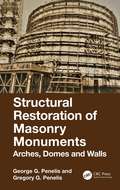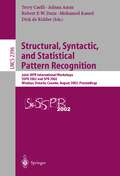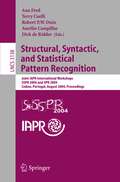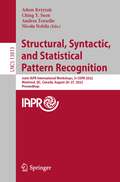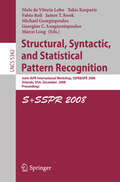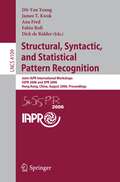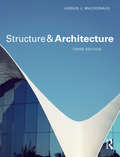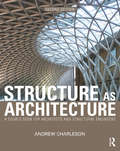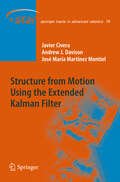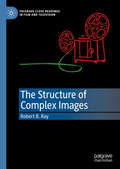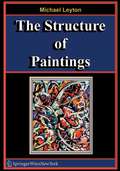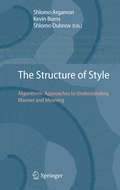- Table View
- List View
Structural Fire Performance of Contemporary Post-tensioned Concrete Construction (SpringerBriefs in Fire)
by John Gales Kathleen Hartin Luke BisbyThis SpringerBrief equips readers to develop defensible fire safety designs for a range of concrete structures. It identifies current gaps in the research and provides a more complete understanding of the structural and thermal response of contemporary Post-tensioned (PT) concrete structures to fire. The brief includes chapters on contemporary construction using PT concrete, previous structural fire test research programs, recent research programs, real fire case studies, and current research needs. It explores the progression of PT concrete structures, looking at the sustainability and aesthetic benefits, the ongoing development of stronger concretes, and best practice guidance for improving safety in the event of fire. Designed for practitioners and researchers in fire engineering, this brief is a valuable tool for those studying the impact of fire on concrete, fire safety designs, and building safety optimization. Advanced-level students in civil engineering will also find the content useful.
Structural Glass Facades and Enclosures
by Mic PattersonA COMPREHENSIVE GUIDE TO STRUCTURAL GLASS FACADES FOR ARCHITECTS, ENGINEERS, AND BUILDERS Once an experimental building form, structural glass facades have matured into a fully robust technology. Structural Glass Facades and Enclosures documents, defines, and categorizes the current state of the art in long-span glass facade design and construction, with a focus on structural systems, glass cladding options, and implementation strategies for innovative design. A comparative analysis of these various systems is included, along with designs and design practices for enhancing transparency; engineering issues; material, process, and fabrication considerations; installation means and methods; and project delivery strategies for implementing innovative building technology in today's construction marketplace. The reader will find information here that is not available together in any single resource, including: Structural system types and design options, with integrated glass system options and their application on each of the structural types An in-depth discussion of design, fabrication, and installation issues relative to each system type, accompanied by illustrations and photographs A discussion of the challenges of implementing innovative design and technology in the construction industry, and operational practices to improve the probability of success A series of in-depth case studies documenting representative samples of stunning built works that employ the technology and design principles identified in the book Structural Glass Facades and Enclosures provides expert content for putting cutting-edge technology into real-life practice, creating new potential for fresh applications embracing both aesthetic and performance solutions, and for the adoption of the technology by architects, builders, and facade practitioners.
Structural Glass Facades and Enclosures
by Mic PattersonA COMPREHENSIVE GUIDE TO STRUCTURAL GLASS FACADES FOR ARCHITECTS, ENGINEERS, AND BUILDERS Once an experimental building form, structural glass facades have matured into a fully robust technology. Structural Glass Facades and Enclosures documents, defines, and categorizes the current state of the art in long-span glass facade design and construction, with a focus on structural systems, glass cladding options, and implementation strategies for innovative design. A comparative analysis of these various systems is included, along with designs and design practices for enhancing transparency; engineering issues; material, process, and fabrication considerations; installation means and methods; and project delivery strategies for implementing innovative building technology in today's construction marketplace. The reader will find information here that is not available together in any single resource, including: Structural system types and design options, with integrated glass system options and their application on each of the structural types An in-depth discussion of design, fabrication, and installation issues relative to each system type, accompanied by illustrations and photographs A discussion of the challenges of implementing innovative design and technology in the construction industry, and operational practices to improve the probability of success A series of in-depth case studies documenting representative samples of stunning built works that employ the technology and design principles identified in the book Structural Glass Facades and Enclosures provides expert content for putting cutting-edge technology into real-life practice, creating new potential for fresh applications embracing both aesthetic and performance solutions, and for the adoption of the technology by architects, builders, and facade practitioners.
Structural Packaging: Design your own Boxes, 3D Forms
by Paul JacksonUnlike other packaging titles, which simply provide templates to copy, this book enables designers of all packaging types to create 3-D packaging forms that are specific to their needs rather than based on an existing design. It teaches a simple ‘net’ construction system – a one-piece 2-D configuration of card seen when a 3-D package is opened out and flattened – which enables the designer to create a huge number of very strong 3-D packaging forms that are both practical and imaginative. Each chapter concludes with photographs and net drawings of 6–10 creative examples of packaging designs made using the principles outlined in the preceding chapter. Structural Packaging gives the reader an understanding of the underlying principles of packaging construction and the technical knowledge and confidence to develop a greater number of their own unusual and innovative designs than any comparable book.Download the crease diagrams from the book for free at www.laurenceking.com
Structural Restoration of Masonry Monuments: Arches, Domes and Walls
by George G. Penelis Gregory G. PenelisHistoric structures need to be restored in line with international guidance and charters developed by architects and archaeologists, but technical understanding of structural engineering and materials is crucial, particularly with respect to response to earthquake loading. This guide to structural assessment and restoration of masonry monuments and historical buildings outlines the techniques, materials and design procedures used. It begins with principles, theory and practice and then presents case studies. The assessment focusses on Building materials and construction techniques used in the past The mechanics of masonry The structural behaviour of masonry monuments and historical buildings In-situ investigation and laboratory tests for existing and restoration materials. The restoration elaborates on Techniques and materials available for structural restoration Structural analysis and design Deciding on the restoration scheme Emergency measures and protective measures.
Structural Restoration of Masonry Monuments: Arches, Domes and Walls
by George G. Penelis Gregory G. PenelisHistoric structures need to be restored in line with international guidance and charters developed by architects and archaeologists, but technical understanding of structural engineering and materials is crucial, particularly with respect to response to earthquake loading. This guide to structural assessment and restoration of masonry monuments and historical buildings outlines the techniques, materials and design procedures used. It begins with principles, theory and practice and then presents case studies. The assessment focusses on Building materials and construction techniques used in the past The mechanics of masonry The structural behaviour of masonry monuments and historical buildings In-situ investigation and laboratory tests for existing and restoration materials. The restoration elaborates on Techniques and materials available for structural restoration Structural analysis and design Deciding on the restoration scheme Emergency measures and protective measures.
Structural, Syntactic, and Statistical Pattern Recognition: Joint IAPR International Workshops SSPR 2002 and SPR 2002, Windsor, Ontario, Canada, August 6-9, 2002. Proceedings (Lecture Notes in Computer Science #2396)
by Terry Caelli Adnan Amin Robert P. W. Duin Mohamed Kamel Dick De RidderThis volume contains all papers presented at SSPR 2002 and SPR 2002 hosted by the University of Windsor, Windsor, Ontario, Canada, August 6-9, 2002. This was the third time these two workshops were held back-to-back. SSPR was the ninth International Workshop on Structural and Syntactic Pattern Recognition and the SPR was the fourth International Workshop on Statis- cal Techniques in Pattern Recognition. These workshops have traditionally been held in conjunction with ICPR (International Conference on Pattern Recog- tion), and are the major events for technical committees TC2 and TC1, resp- tively, of the International Association of Pattern Recognition (IAPR). The workshops were held in parallel and closely coordinated. This was an attempt to resolve the dilemma of how to deal, in the light of the progressive specialization of pattern recognition, with the need for narrow-focus workshops without further fragmenting the ?eld and introducing yet another conference that would compete for the time and resources of potential participants. A total of 116 papers were received from many countries with the submission and reviewingprocesses beingcarried out separately for each workshop. A total of 45 papers were accepted for oral presentation and 35 for posters. In addition four invited speakers presented informative talks and overviews of their research. They were: Tom Dietterich, Oregon State University, USA Sven Dickinson, the University of Toronto, Canada Edwin Hancock, University of York, UK Anil Jain, Michigan State University, USA SSPR 2002 and SPR 2002 were sponsored by the IAPR and the University of Windsor.
Structural, Syntactic, and Statistical Pattern Recognition: Joint IAPR International Workshops, SSPR 2004 and SPR 2004, Lisbon, Portugal, August 18-20, 2004 Proceedings (Lecture Notes in Computer Science #3138)
by Ana Fred Terry Caelli Robert P. W. Duin Aurélio Campilho Dick De RidderStructural, Syntactic, and Statistical Pattern Recognition: Joint IAPR International Workshops, S+SSPR 2022, Montreal, QC, Canada, August 26–27, 2022, Proceedings (Lecture Notes in Computer Science #13813)
by Adam Krzyzak Ching Y. Suen Andrea Torsello Nicola NobileThis book constitutes the proceedings of the Joint IAPR International Workshop on Structural, Syntactic, and Statistical Pattern Recognition, S+SSPR 2022, held in Montreal, QC, Canada, in August 2022.The 30 papers together with 2 invited talks presented in this volume were carefully reviewed and selected from 50 submissions. The workshops presents papers on topics such as deep learning, processing, computer vision, machine learning and pattern recognition and much more.
Structural, Syntactic, and Statistical Pattern Recognition: Joint IAPR International Workshop, SSPR & SPR 2008, Orlando, USA, December 4-6, 2008. Proceedings (Lecture Notes in Computer Science #5342)
by Niels Da Vitoria Lobo Takis Kasparis Michael Georgiopoulos Fabio Roli James Kwok Georgios C. Anagnostopoulos Marco LoogThis volume in the Springer Lecture Notes in Computer Science (LNCS) series contains 98 papers presented at the S+SSPR 2008 workshops. S+SSPR 2008 was the sixth time that the SPR and SSPR workshops organized by Technical Committees, TC1 and TC2, of the International Association for Pattern Rec- nition (IAPR) wereheld as joint workshops. S+SSPR 2008was held in Orlando, Florida, the family entertainment capital of the world, on the beautiful campus of the University of Central Florida, one of the up and coming metropolitan universities in the USA. S+SSPR 2008 was held during December 4–6, 2008 only a few days before the 19th International Conference on Pattern Recog- tion(ICPR2008),whichwasheldin Tampa,onlytwo hoursawayfromOrlando, thus giving the opportunity of both conferences to attendees to enjoy the many attractions o?ered by two neighboring cities in the state of Florida. SPR 2008 and SSPR 2008 received a total of 175 paper submissions from many di?erent countries around the world, thus giving the workshop an int- national clout, as was the case for past workshops. This volume contains 98 accepted papers: 56 for oral presentations and 42 for poster presentations. In addition to parallel oral sessions for SPR and SSPR, there was also one joint oral session with papers of interest to both the SPR and SSPR communities. A recent trend that has emerged in the pattern recognition and machine lea- ing research communities is the study of graph-based methods that integrate statistical andstructural approaches.
Structural, Syntactic, and Statistical Pattern Recognition: Joint IAPR International Workshops, SSPR 2006 and SPR 2006, Hong Kong, China, August 17-19, 2006, Proceedings (Lecture Notes in Computer Science #4109)
by Dit-Yan Yeung James T. Kwok Ana Fred Fabio Roli Dick De RidderThis is the proceedings of the 11th International Workshop on Structural and Syntactic Pattern Recognition, SSPR 2006 and the 6th International Workshop on Statistical Techniques in Pattern Recognition, SPR 2006, held in Hong Kong, August 2006 alongside the Conference on Pattern Recognition, ICPR 2006. 38 revised full papers and 61 revised poster papers are included, together with 4 invited papers covering image analysis, character recognition, bayesian networks, graph-based methods and more.
Structure and Architecture
by Angus J. MacdonaldThis thoroughly updated edition of Angus J. Macdonald’s insightful book Structure and Architecture offers an in depth analysis of structural design and its relationship with architecture. It draws on clear explanations of the connections between structural form, structural performance and architectural design to explore the interface between the technical and the visual in architecture. Additional chapters in this new edition cover the fields of structural theory, structural philosophy, the contributions of prominent engineers to the evolution of Modern architecture, and the concept and practice of sustainable design. Fully illustrated, this critical appraisal of structures is a core-curriculum text for students of architecture, structural engineering and architectural history, and is also a valuable resource for practitioners of these disciplines.
Structure and Architecture
by Angus J. MacdonaldThis thoroughly updated edition of Angus J. Macdonald’s insightful book Structure and Architecture offers an in depth analysis of structural design and its relationship with architecture. It draws on clear explanations of the connections between structural form, structural performance and architectural design to explore the interface between the technical and the visual in architecture. Additional chapters in this new edition cover the fields of structural theory, structural philosophy, the contributions of prominent engineers to the evolution of Modern architecture, and the concept and practice of sustainable design. Fully illustrated, this critical appraisal of structures is a core-curriculum text for students of architecture, structural engineering and architectural history, and is also a valuable resource for practitioners of these disciplines.
Structure and Form in Design: Critical Ideas for Creative Practice
by Michael HannThis book provides a critical examination of structure and form in design, covering a range of topics of great value to students and practitioners engaged in any of the specialist decorative arts and design disciplines. The complexities of two-dimensional phenomena are explained and illustrated in detail, while various three-dimensional forms are also discussed.In the context of the decorative arts and design, structure is the underlying framework, and form the resultant, visible, two- or three-dimensional outcome of the creative process. Whether hidden or visually detectable in the final design, structure invariably determines whether or not a design is successful in terms of both its aesthetics and its practical performance. Hann successfully identifies various geometric concepts, and presents and discusses a number of simple guidelines to assist the creative endeavours of both accomplished and student practitioners, teachers and researchers.
Structure and Form in Design: Critical Ideas for Creative Practice
by Michael HannThis book provides a critical examination of structure and form in design, covering a range of topics of great value to students and practitioners engaged in any of the specialist decorative arts and design disciplines. The complexities of two-dimensional phenomena are explained and illustrated in detail, while various three-dimensional forms are also discussed.In the context of the decorative arts and design, structure is the underlying framework, and form the resultant, visible, two- or three-dimensional outcome of the creative process. Whether hidden or visually detectable in the final design, structure invariably determines whether or not a design is successful in terms of both its aesthetics and its practical performance. Hann successfully identifies various geometric concepts, and presents and discusses a number of simple guidelines to assist the creative endeavours of both accomplished and student practitioners, teachers and researchers.
Structure As Architecture: A Source Book for Architects and Structural Engineers
by Andrew CharlesonStructure as Architecture presents a comprehensive analysis of the indispensable role of structure in architecture. An exploration, as well as a celebration, of structure, the book draws on a series of design studies and case study examples to illustrate how structure can be employed to realize a wide range of concepts in contemporary architecture. By examining design principles that relate to both architecture and structural engineering, Andrew Charleson provides new insights into the relationship between both the technical and aesthetic aspects of architecture. Now in its second edition, the text has been extensively revised and updated throughout. Features include: A brand new chapter on hidden structure, adding to the material on exposed structures Two new chapters on using structure to realise common architectural concepts through a combination of precedents and creative design Over 50 new case studies from across the globe Easy-to-understand diagrams and a highly visual design to aid understanding and accessibility More than two hundred case studies of contemporary buildings from countries such as the UK, the US, France, Germany, Spain, Hong Kong, Australia and Japan illustrate how a thorough integration of structure adds layers of richness and enhances the realisation of architectural design concepts.
Structure As Architecture: A Source Book for Architects and Structural Engineers
by Andrew CharlesonStructure as Architecture presents a comprehensive analysis of the indispensable role of structure in architecture. An exploration, as well as a celebration, of structure, the book draws on a series of design studies and case study examples to illustrate how structure can be employed to realize a wide range of concepts in contemporary architecture. By examining design principles that relate to both architecture and structural engineering, Andrew Charleson provides new insights into the relationship between both the technical and aesthetic aspects of architecture. Now in its second edition, the text has been extensively revised and updated throughout. Features include: A brand new chapter on hidden structure, adding to the material on exposed structures Two new chapters on using structure to realise common architectural concepts through a combination of precedents and creative design Over 50 new case studies from across the globe Easy-to-understand diagrams and a highly visual design to aid understanding and accessibility More than two hundred case studies of contemporary buildings from countries such as the UK, the US, France, Germany, Spain, Hong Kong, Australia and Japan illustrate how a thorough integration of structure adds layers of richness and enhances the realisation of architectural design concepts.
Structure for Architects: A Case Study in Steel, Wood, and Reinforced Concrete Design
by Ashwani Bedi Ramsey DabbyStructure for Architects: A Case Study in Steel, Wood, and Reinforced Concrete Design is a sequel to the authors’ first text, Structure for Architects: A Primer, emphasizing the conceptual understanding of structural design in simple language and terms. This book focuses on structural principles applied to the design of typical structural members—a beam, a girder, and a column—in a diagrammatic frame building. Through the application of a single Case Study across three key materials, the book illustrates the theory, principles, and process of structural design. The Case Study progresses step-by-step for each material, from determining tributary areas and loads through a member's selection and design. The book addresses the frequent disparity between the way architects and engineers perceive and process information, with engineers focusing on technical aspects and architects focusing on visual concepts. Structure for Architects: A Case Study in Steel, Wood, and Reinforced Concrete Design presents readers with an understanding of fundamental engineering principles through a uniquely thematic Case Study. Focusing on the conceptual understanding of structural design, this book will be of interest to architecture students and professionals looking to understand the application of structural principles in relation to steel, wood, and concrete design.
Structure for Architects: A Case Study in Steel, Wood, and Reinforced Concrete Design
by Ashwani Bedi Ramsey DabbyStructure for Architects: A Case Study in Steel, Wood, and Reinforced Concrete Design is a sequel to the authors’ first text, Structure for Architects: A Primer, emphasizing the conceptual understanding of structural design in simple language and terms. This book focuses on structural principles applied to the design of typical structural members—a beam, a girder, and a column—in a diagrammatic frame building. Through the application of a single Case Study across three key materials, the book illustrates the theory, principles, and process of structural design. The Case Study progresses step-by-step for each material, from determining tributary areas and loads through a member's selection and design. The book addresses the frequent disparity between the way architects and engineers perceive and process information, with engineers focusing on technical aspects and architects focusing on visual concepts. Structure for Architects: A Case Study in Steel, Wood, and Reinforced Concrete Design presents readers with an understanding of fundamental engineering principles through a uniquely thematic Case Study. Focusing on the conceptual understanding of structural design, this book will be of interest to architecture students and professionals looking to understand the application of structural principles in relation to steel, wood, and concrete design.
Structure for Architects: A Primer
by Ramsey Dabby Ashwani BediAn introduction to the concepts and principles of architectural structures in an easy-to-read format Written as an easy-to-understand primer on the topic, Structure for Architects engages readers through instruction that uses a highly visual format and real-world examples to underline the key facets of structural principles that are essential to the design process. Eschewing complicated mathematics and technical jargon, Structure for Architects demystifies the subject matter by showing it in the context of everyday situations, giving architects and architectural technologists a clear understanding of how to incorporate structural principles into their designs. Highlights of this book include: A rich collection of drawings, photographs, and diagrams, spread throughout the text, which demonstrate fundamental structural concepts using everyday examples An overview of structural design basics, as well as a summary of structural forms A look at the design implications of steel, reinforced concrete, and wood By providing an overall view of structures that covers the essentials of what architects and architectural technologists need to know, Structure for Architects is a valuable tool for illustrating the importance of designing with structure in mind and for learning the basics that are necessary for collaborating confidently with project team members.
Structure for Architects: A Primer
by Ramsey Dabby Ashwani BediAn introduction to the concepts and principles of architectural structures in an easy-to-read format Written as an easy-to-understand primer on the topic, Structure for Architects engages readers through instruction that uses a highly visual format and real-world examples to underline the key facets of structural principles that are essential to the design process. Eschewing complicated mathematics and technical jargon, Structure for Architects demystifies the subject matter by showing it in the context of everyday situations, giving architects and architectural technologists a clear understanding of how to incorporate structural principles into their designs. Highlights of this book include: A rich collection of drawings, photographs, and diagrams, spread throughout the text, which demonstrate fundamental structural concepts using everyday examples An overview of structural design basics, as well as a summary of structural forms A look at the design implications of steel, reinforced concrete, and wood By providing an overall view of structures that covers the essentials of what architects and architectural technologists need to know, Structure for Architects is a valuable tool for illustrating the importance of designing with structure in mind and for learning the basics that are necessary for collaborating confidently with project team members.
Structure from Motion using the Extended Kalman Filter (Springer Tracts in Advanced Robotics #75)
by Javier Civera Andrew J. Davison José María Martínez MontielThe fully automated estimation of the 6 degrees of freedom camera motion and the imaged 3D scenario using as the only input the pictures taken by the camera has been a long term aim in the computer vision community. The associated line of research has been known as Structure from Motion (SfM). An intense research effort during the latest decades has produced spectacular advances; the topic has reached a consistent state of maturity and most of its aspects are well known nowadays. 3D vision has immediate applications in many and diverse fields like robotics, videogames and augmented reality; and technological transfer is starting to be a reality. This book describes one of the first systems for sparse point-based 3D reconstruction and egomotion estimation from an image sequence; able to run in real-time at video frame rate and assuming quite weak prior knowledge about camera calibration, motion or scene. Its chapters unify the current perspectives of the robotics and computer vision communities on the 3D vision topic: As usual in robotics sensing, the explicit estimation and propagation of the uncertainty hold a central role in the sequential video processing and is shown to boost the efficiency and performance of the 3D estimation. On the other hand, some of the most relevant topics discussed in SfM by the computer vision scientists are addressed under this probabilistic filtering scheme; namely projective models, spurious rejection, model selection and self-calibration.
The Structure of Complex Images (Palgrave Close Readings in Film and Television)
by Robert B. RayAfter over a century of existence, the cinema still has its mysteries. Why, for example, is the job we call movie stardom unlike any other in the world? How do films provide so much unconcealed information that we fail to notice? What makes it hard to define what counts as “acting”? How do movies like Casablanca and Breathless store the film and world histories of their generations? How can we reconcile auteurism’s celebration of the movie director’s authority with the camera’s automatism? Why have the last four decades of film criticism so often neglected such questions? After beginning with an overview of film studies, this book proposes a shift from predictable theoretical approaches to models that acknowledge the perplexities and mysteries of the movies. Deriving methods from cinephilia, Wittgenstein, Richard Rorty, Stanley Cavell, Eleanor Duckworth, V. F. Perkins, and James Naremore, Robert B. Ray offers close readings that call attention to what we have missed in such classic films as La Règle du Jeu, It Happened One Night, It’s a Wonderful Life, Vertigo, Holiday, The Philadelphia Story, Casablanca, Breathless, and Tickets.
The Structure of Paintings
by Michael LeytonMichael Leyton has developed new foundations for geometry in which shape is equivalent to memory storage. A principal argument of these foundations is that artworks are maximal memory stores. The theory of geometry is developed from Leyton's fundamental laws of memory storage, and this book shows that these laws determine the structure of paintings. Furthermore, the book demonstrates that the emotion expressed by a painting is actually the memory extracted by the laws. Therefore, the laws of memory storage allow the systematic and rigorous mapping not only of the compositional structure of a painting, but also of its emotional expression. The argument is supported by detailed analyses of paintings by Picasso, Raphael, Cezanne, Gauguin, Modigliani, Ingres, De Kooning, Memling, Balthus and Holbein.
The Structure of Style: Algorithmic Approaches to Understanding Manner and Meaning
by Shlomo Argamon Kevin Burns Shlomo DubnovStyle is a fundamental and ubiquitous aspect of the human experience: Everyone instantly and constantly assesses people and things according to their individual styles, academics establish careers by researching musical, artistic, or architectural styles, and entire industries maintain themselves by continuously creating and marketing new styles. Yet what exactly style is and how it works are elusive: We certainly know it when we see it, but there is no shared and clear understanding of the diverse phenomena that we call style. The Structure of Style explores this issue from a computational viewpoint, in terms of how information is represented, organized, and transformed in the production and perception of different styles. New computational techniques are now making it possible to model the role of style in the creation of and response to human artifacts—and therefore to develop software systems that directly make use of style in useful ways. Argamon, Burns, and Dubnov organize the research they have collected in this book according to the three roles that computation can play in stylistics. The first section of the book, Production, provides conceptual foundations by describing computer systems that create artifacts—musical pieces, texts, artworks—in different styles. The second section, Perception, explains methods for analyzing different styles and gleaning useful information, viewing style as a form of communication. The final section, Interaction, deals with reciprocal interaction between style producers and perceivers, in areas such as interactive media, improvised musical accompaniment, and game playing. The Structure of Style is written for researchers and practitioners in areas including information retrieval, computer art and music, digital humanities, computational linguistics, and artificial intelligence, who can all benefit from this comprehensive overview and in-depth description of current research in this active interdisciplinary field.



